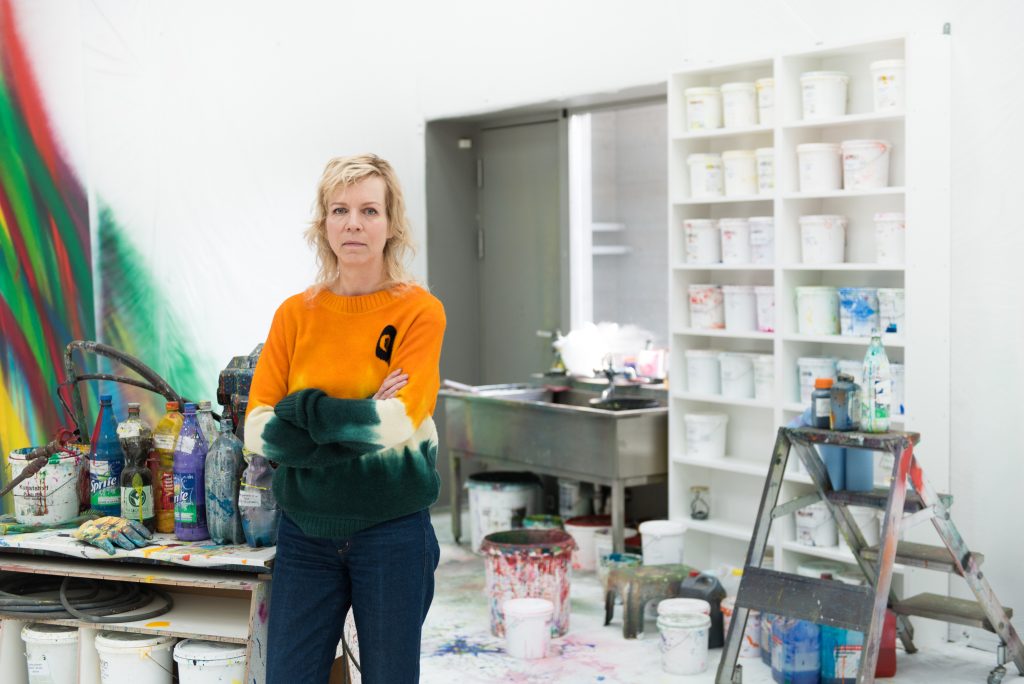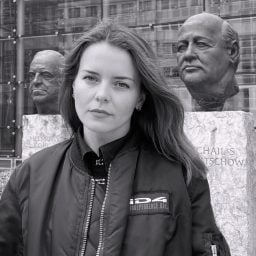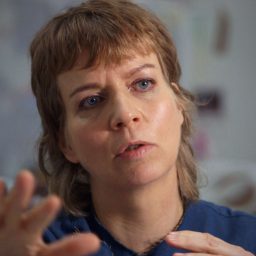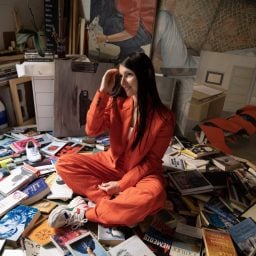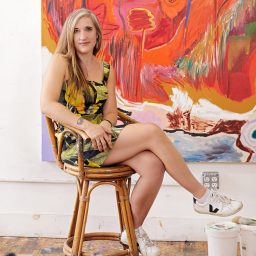German painter Katharina Grosse was in the middle of installing one of her largest shows to date, at the prestigious Hamburger Bahnhof in Berlin, when the lockdown threw the museum’s schedule into disarray.
Luckily for Grosse, she had been given the keys to the (now considerably quieter) museum, located just a stone’s throw from her studio. She embraced the unexpected delay; by the time the doors finally reopened, her technicolor paintings had found their way onto the exterior gallery walls and across the floors, where a titanic, carved installation curled up toward the roof.
Grosse’s works often resemble smashes of color that lick the architecture of white cubes or land on felled trees and wind-torn houses with a boundless energy that is undeniably her own. On the other side of the ocean, at the Baltimore Museum of Art, where Grosse opened a show earlier this year, her vibrant curtains gently undulate, dropping down from the ceiling to create mountainous color fields inside the gallery.
These two major projects may be complete, but the artist isn’t taking a break. She was working in her glass and concrete studio when we met last week, looking over small models for her upcoming exhibitions at Berlin’s Galerie König and Gagosian’s Rome space at the end of October. When those shows are over, she said, she will retreat to her third studio on a cliffside in New Zealand.
Grosse spoke to Artnet News about the hidden benefits of pulling together a blockbuster under lockdown, why she doesn’t mind her work being looked at online, and why giant splashes of color can be food for thought.
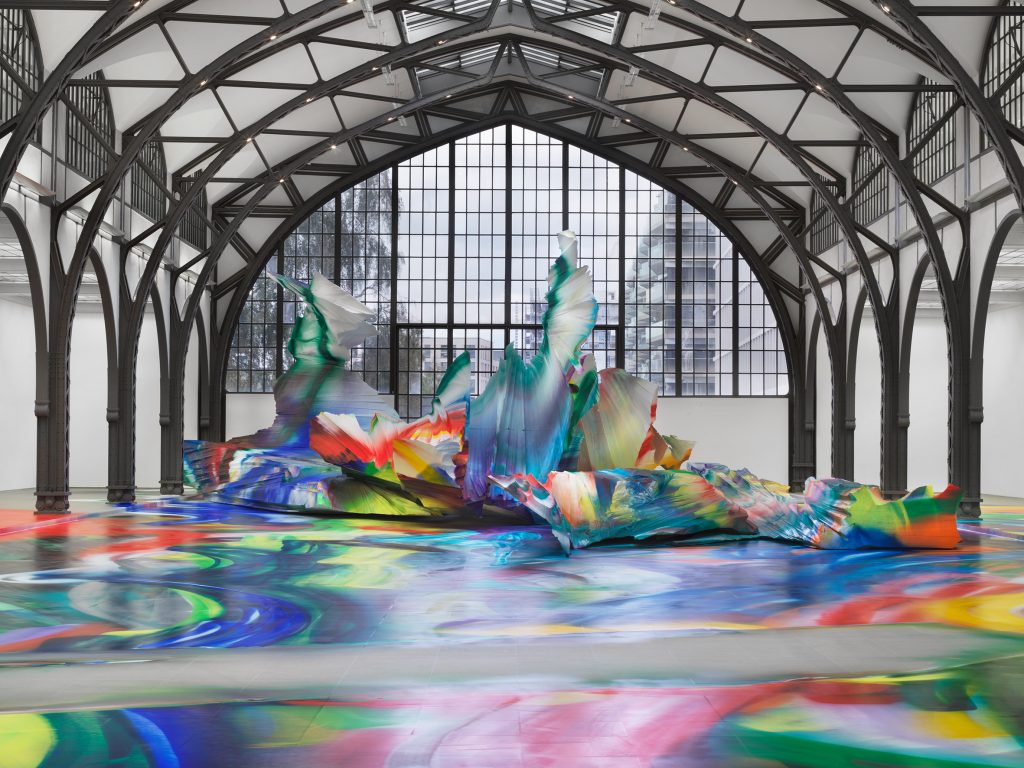
“Katharina Grosse. It Wasn’t Us“, exhibition view Hamburger Bahnhof – Museum für Gegenwart – Berlin, 2020 / Courtesy König Galerie, Gagosian, Galerie Nächst St. Stephan Rosemarie Schwarzwälder © Katharina Grosse / VG Bild-Kunst, Bonn 2020 / Photo: Jens Ziehe
You made your current exhibition, “It Wasn’t Us” at the Hamburger Bahnhof, in the middle of lockdown. What was that experience like?
The show was complex because of the travel restrictions. I have never worked like that, with another company that was pre-carving the whole piece near Hannover.
Together with my assistants I did some refinement of the shape of the sculpture with a hot wire there and finished the cutting here in Berlin. We were fortunate to get all the different components shipped well before the lockdown. In the end, we had an additional week to set up the sculpture and then I had another week more to paint it, and that was really good for the show.
There was a moment when we were not sure when or if the show was going to open at all, and that was interesting because I still stopped working after a specific time frame. It really was like studio work. I was able to come and go as I pleased, in and out of the museum, because nothing else was going on at that time. I could really bring everything to a point where I was satisfied.
Your work is very considerate of its environment. What kinds of sites and spaces most interest you?
The work that I do tends to take up space that is not traditional museum space. It’s good when these pieces are placed in the middle of some sort of conflict zone, which I do not mean as a negative word, but rather as a position where things can tip and transform from one situation to another. The hierarchies at these locations are usually somehow fragile— they can be swiveled around, depending on the work.
For my project Rockaway in 2016, for example, I painted a beach house that was formerly a military barrack, filled with sand from Hurricane Sandy. There was a certain unclarity as to whether the house was disappearing under the sand or emerging [from it].
I am interested in showing and finding out where paintings can appear in our everyday life. A painting isn’t supposed to be only on a wall, or locked in a room. It can be anywhere. It doesn’t have a fixed location—traditionally, it’s only in the last 200 or 300 years that we began to carry paintings around, selling them and hanging them in different locations, which I think is also great.
But a painting can be on a rock, in a church, or on the side of a house. It can be on stamps, or in books—basically anywhere.
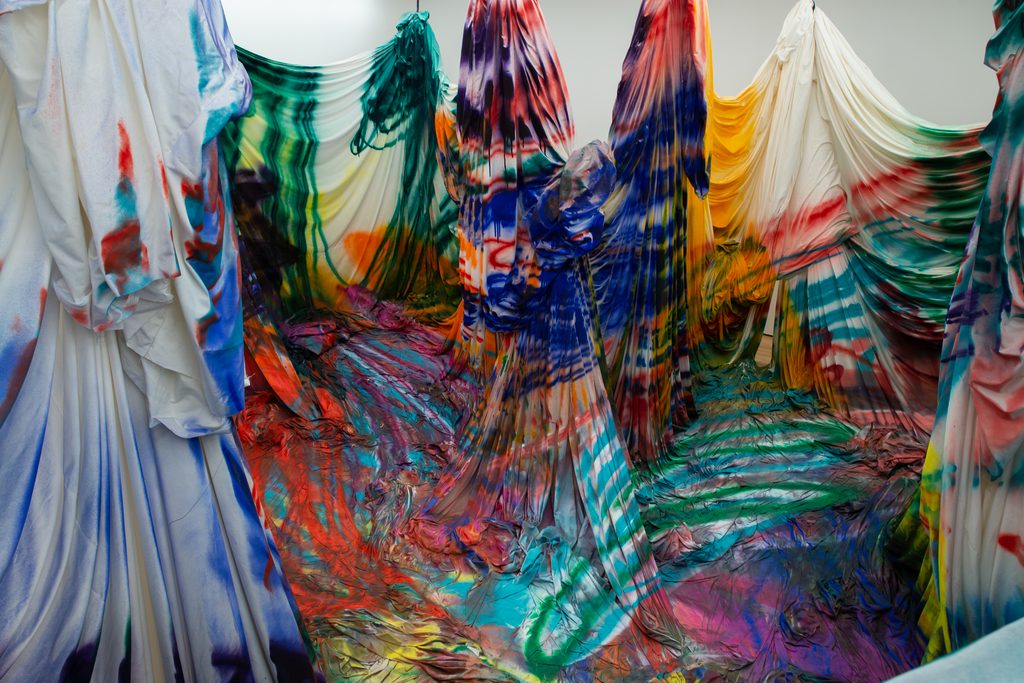
Katharina Grosse, “Is It You?,” 2020, The Baltimore Museum of Art, USA, Photo: Mitro Hood, courtesy of The Baltimore Museum of Art ©2020 Katharina Grosse and VG Bild-Kunst, Bonn, 2020.
How did you come to this realization?
It has never been something that I had to discover. When I first studied painting, I naturally just painted everywhere, on a wall or on a chair, to try things out. I liked these different surfaces and how colors behaved differently: they could manipulate you and change your perceptions of the materials that you’re looking at. A piece of wood does something to the color pink that concrete does not, for example.
In terms of creating installations in museums, like your Hamburger Bahnhof show, I wonder how much the work is about facing off against some of the rules about what is allowed in these spaces.
Yes, the work does have to do with that. As an artist invited to do a show, you see a situation as a person coming from the outside, whether it’s at an institution or in a certain set of buildings or in an outdoor area. Instead of trying to fit into the space, I ask myself how a painting could live in that space and still have the utmost independence. Because then, when people come visit the space, they also experience a sense of independence and encounter the possibility of possibilities.
In that sense, I am not looking to break rules, but rather, looking for alternatives of how space could be.
The qualities of the spaces you work in become more apparent when set against your installations. You’re not just covering them up, but giving them new life, in a sense.
I find that interesting. Sometimes the work makes the spaces look even more prominent, like in the Hamburger Bahnhof, where you encounter the steel columns and its very sturdy, strict architecture. The detail of where the old columns meet the exhibition floor, for example, shows two worlds meeting that are not of the same purpose, the same ideology, or the same time, and that all becomes accentuated. I am very interested in the meeting point of paradoxical things.
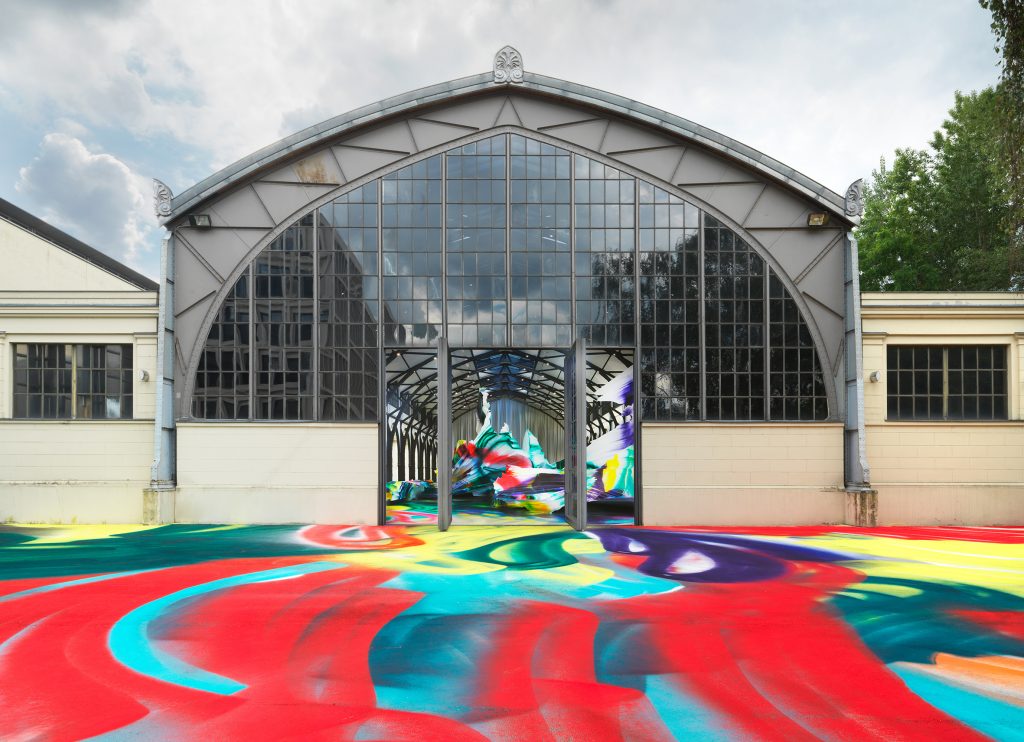
“Katharina Grosse. It Wasn’t Us“, exhibition view Hamburger Bahnhof – Museum für Gegenwart – Berlin, 2020 / Courtesy König Galerie, Gagosian, Galerie Nächst St. Stephan Rosemarie Schwarzwälder © Katharina Grosse / VG Bild-Kunst, Bonn 2020 / Photo: Jens Ziehe.
Since your work manifests in ambitious installations, I wonder, do you ever feel that you are given limitations that you cannot work with?
If I feel that this is the case, then I won’t do it. You have a certain thing in mind that is usually the boldest idea, at the same time you have to look at how it can be done in reality. There are some things that are essential: At the Hamburger Bahnhof, for example, I would not have done the project if I was not allowed to paint outside. That was an important twist.
I am curious about how you navigate your work’s scale. After doing a large installation, do you feel like you need an even bigger space to challenge yourself further?
The size only matters in relation to what the location needs—I am always trying to make the smallest possible version of a large piece. Scale has a very emotional and psychological quality. It is not size that matters to me, but rather how the work appears. A very small work can have a similar effect on you psychologically as a very big work in relation to the space it’s in.
Scale plays a role in the process of painting, too. I use my whole body to make the work and I walk quite some distances. I work on several paintings at the same time. One of my studios is very large so that I can work on 20 paintings at a time. Sometimes, you cannot even see where one painting stops and the next starts, because everything blends together and becomes one painting. The walls are painted. Everything is painted—and it is very exciting to work like that.
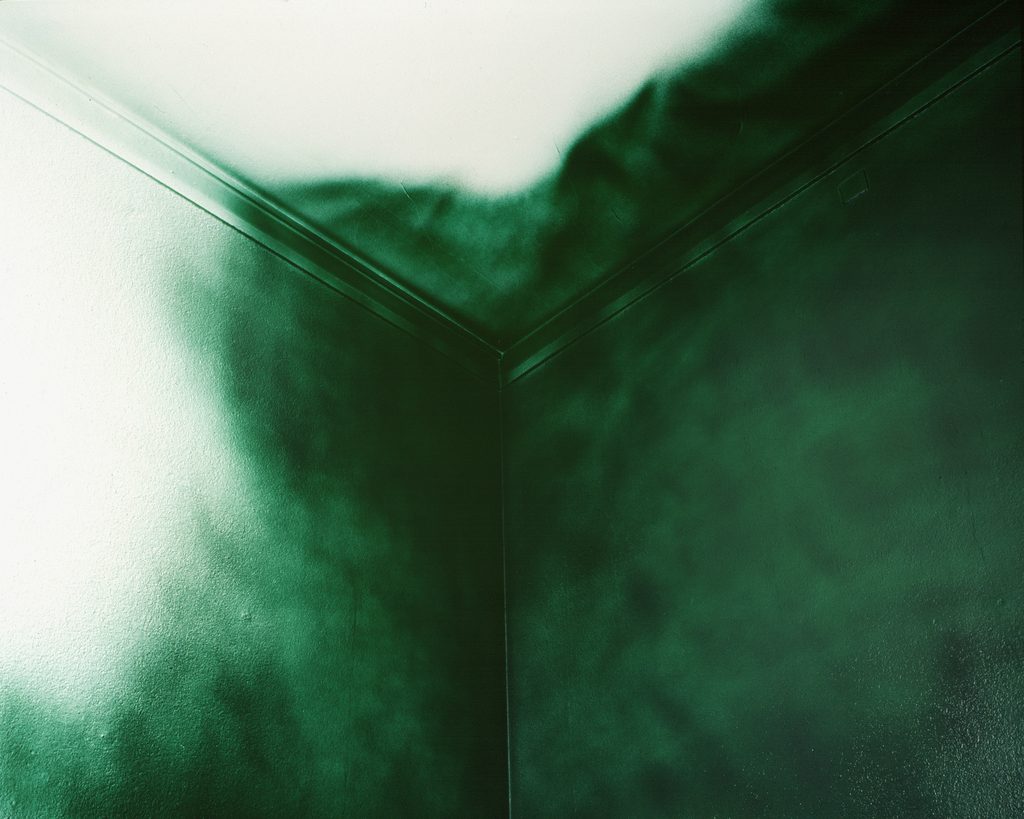
Katharina Grosse, o. T., project space, Kunsthalle Bern, 1998. Photo: Michael Fontana; Courtesy: Kunsthalle Bern© Katharina Grosse und VG Bild-Kunst, Bonn, 2020.
You are rapidly becoming one of the biggest names in contemporary German painting, which has historically been—and in some ways, still is—a very male-dominated field.
It is a very male-dominated field, but so is society. We are very lagging in Germany with this idea of giving perspectives to different speakers and voices and thoughts. It is not to say that the work of white males is rubbish, but half of society should not be excluded from having a say.
I didn’t realize the problems of being so dominated by patriarchal thinking until I left art school. The way I grew up and the friends of my parents never gave me that feeling. It was the same during art school and university. Perhaps I was shielded from it, in a way. A lot of my female friends did say to me, though, “Hey, are you crazy? Either you go into performative or video art, new fields primarily taken up by women. Painting is so overloaded by patriarchal structures. How will you be successful?”
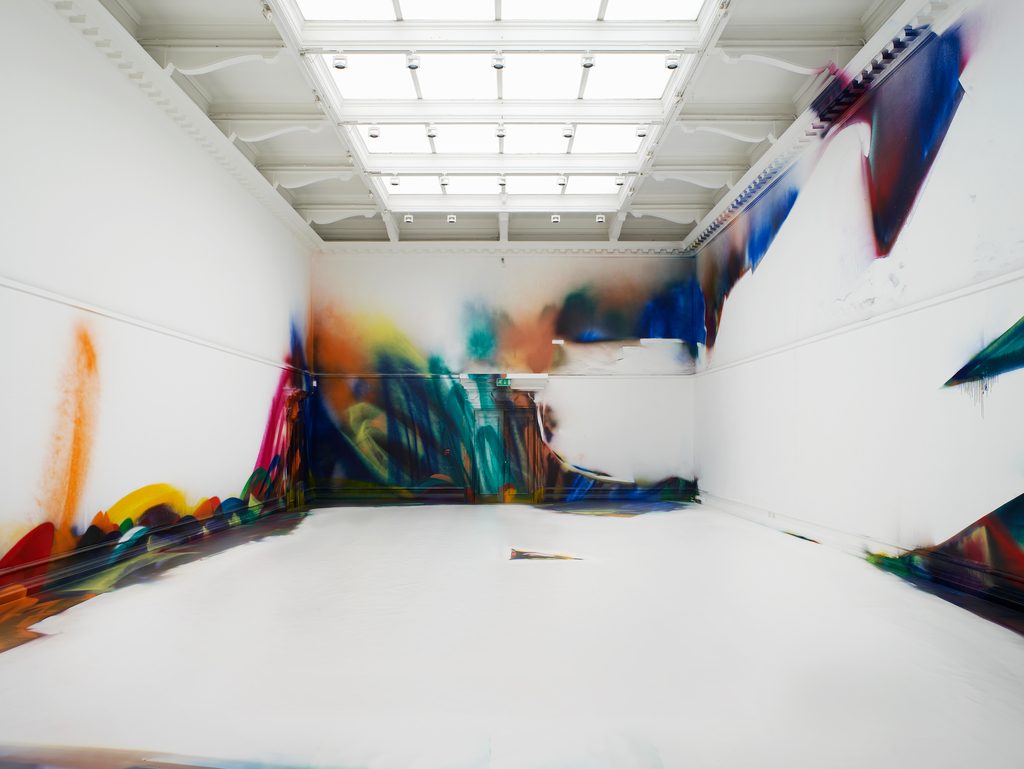
Katharina Grosse, “This Drove my Mother up the Wall”, 2017, South London Gallery, London, UK.
It also must be strange to make work that immerses visitors in a very physical way, given that so much art is being seen and understood online right now.
My work is really about a haptic experience where your body can be stimulated. The screen does not do that. One’s eyes can be stimulated, but the rest of the body remains passive. Yet aspects of the work exist online that you cannot see in the space, too, which I find interesting. The photography shows you something that you cannot see while you are standing there, an experience that is far more particular. I think all the different ways of communicating a work have their own unique impact. The more that is available, the better.
What’s your relationship to abstraction?
I don’t see my work as being abstracted from the world. I don’t think that a painting puts forward a set of rules that only refers to itself. A painting is an open structure that has to overlap with the world. My central question is: how can a painting appear in the world other than as a canvas on a wall? I want to suggest a new version of space, and the piece at the Hamburger Bahnhof perhaps shows how that can be done.
I understand why you ask about abstraction, though. The term describes something that cannot be named, that isn’t represented by something else [already] in existence. You see these large sculptural pieces at Hamburger Bahnhof, and you may say that they look like icebergs or landscapes or shards. Whenever you name them, you also realize that they’re not, in fact, like the things you’re comparing them to. You have all these words for them, but you cannot really say what they are.
It is interesting to make visible what cannot be named. But this is not a futurist proposal—it already exists. And I think that is kind of a political program [in itself]. People walk on the work and become a part of it.
